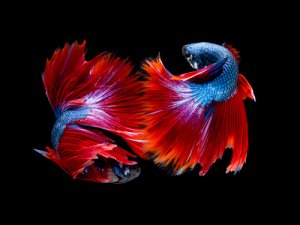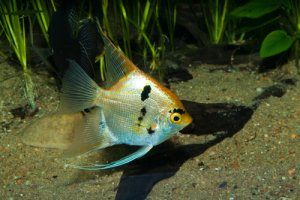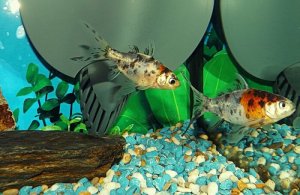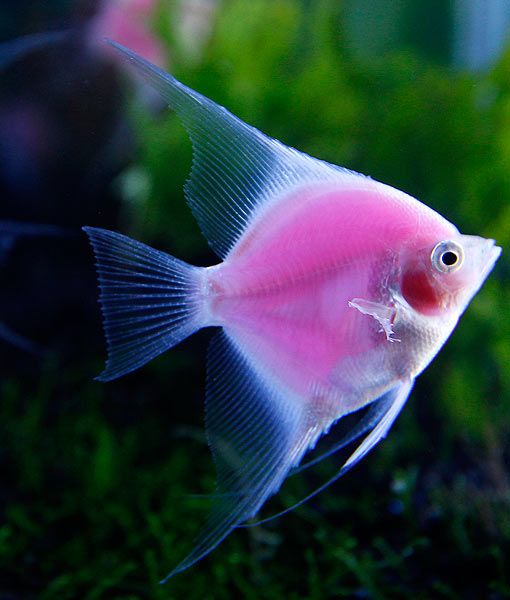
The Pink Angelfish is a very rare color variation that was genetically enhanced to get the Fluorescent pink color.
The first pink fluorescent Pterophyllum scalare, known as the Pink Angelfish was showcased in an exhibit at the Taiwan International Aquarium Expo.
Angelfish in general are the cornerstone of the freshwater aquarist hobby because these fish have such a renowned shape with outstanding personalities, and they are very easy to keep.
Breed Overview
| Origin | The Pink Freshwater Angelfish originates from South America, mostly the Amazon basin and Orinoco Basin. |
| Lifespan | The Angelfish in general has a Lifespan of up to 12 years in captivity and 15 years in the wild. |
| Size | Similar to most species of Freshwater Angelfish they are around 6 inches in length and 8 inches or more in height. |
| Colour | The Pink Angelfish will have a fluorescent pink color or a basic pinkish body. |
| Food | Omnivorous. |
| Tank Size | You will need a Taller Tank of around 20 -30 gallons. |
| Temperament | Angelfish in general are peaceful and tend to school, however when they pair off they do get territorial. |
| Water Type | Clear or Silty Fresh Water. Soft and slightly Acidic water conditions. |
| Water Temperature | Water temperatures of around 26-30 degrees Celsius, or (75-86 Fahrenheit). |
| Water pH | An acidic to neutral pH of between 6.0 and 7.0. Nitrates below 100 Mg and Water Hardness of between 0-6. |
| Difficulty Level | They are ideal for beginners and all freshwater aquarists. |
Species Information
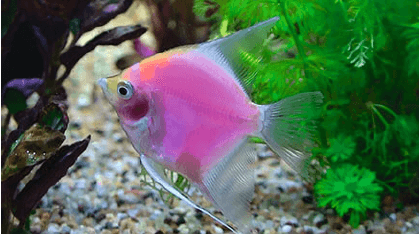
The Pink Angelfish is a genetically enhanced species of Pterophyllum Scalare, a freshwater fish known as the Angelfish that is part of the Cichlidae family.
Though there are over 32 different colors of angelfish most of them lacked the cells needed to create a pink colored Angelfish. However, after three years of research, they were able to modify the colors of the Angelfish to get a pink colored Angelfish.
You can read more about the genetics of the Freshwater Pink Angelfish in the Taipei Times.
According to Wikipedia, Angelfish have a unique body shape that is round and laterally compressed, with elongated dorsal and anal fins. Their body shape allows them to easily hide among leaves, roots, and even vertical surfaces.
Angelfish are naturally Monogamous and will select a single partner, they are ambush predators that will many times prey on smaller fish.
Color Variations Of The Freshwater Angelfish
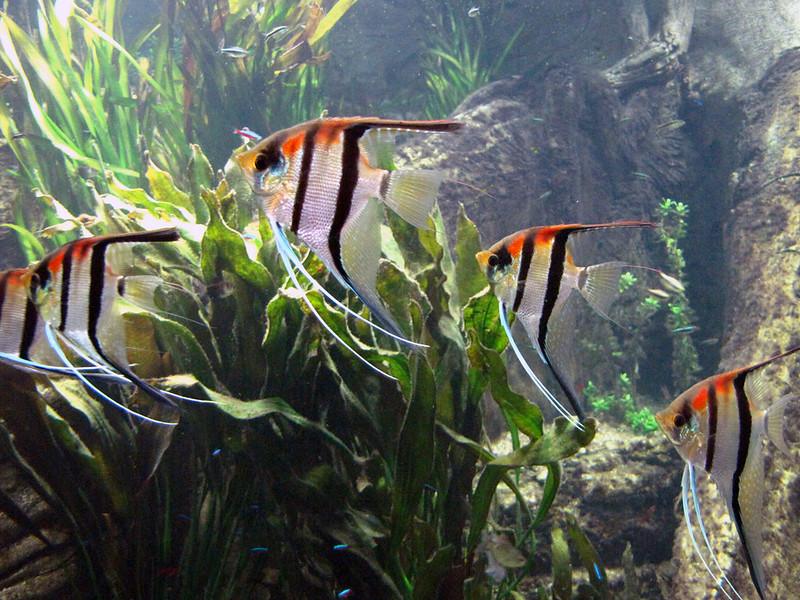
In the early years of producing Angelfish, there were only a few color variations available, such as silver, black marble, black, and black lace. You also have two different fin varieties including the regular veil and super veiled species with much more elaborate fins.
Here are a few different color variations from the Pterophyllum Scalare, which is the species to which the Freshwater Pink Angelfish belongs to;
- Silver – The “Wild Type” of Freshwater Angelfish, usually has four vertical black stripes.
- Gold – The most attractive and hardy.
- Zebra – Silver with Extra Stripes, you also get a Zebra Lace.
- Smokey – Has dark brownish-gray back halves and darker dorsals.
- Chocolate – More smokey brown with darker patterns.
- Half Black – Black and silver.
- Sunset Blushing – Gold and Stripeless colors, with pinkish gills.
- Koi – Gold and Black Marbling.
- Leopard – Similar to Chocolate with spots on it.
- Blue Blushing – Grey with a Bluish tint.
- Silver Gold Marble – Silver with Gold Marbling.
- Black – More solid black with red eyes.
- Albino or White – Completely white usually with pink eyes.
- Pearlscale – Has wrinkled wavy scales that reflect light to resemble pearls.
Freshwater Pink Angelfish Size
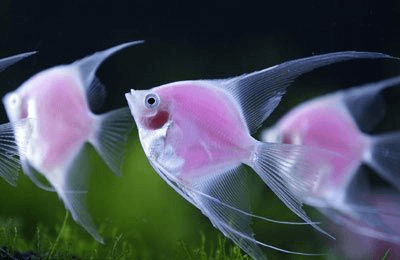
The Pink Angelfish will generally be the same size as most freshwater Angelfish. They usually grow to about between 4 and 6 inches in length, and 6 to 8 inches in height, in captivity. Keep in mind that they may grow much larger in the wild.
General Care
The Pink Angelfish is captive-bred and forms part of the most commonly kept Angelfish species the Pterophyllum Scalare. Though they are anything but common angelfish are hardy with beautiful personalities and elegant and outstanding shapes.
They are an easy choice for any beginner or even more advanced Aquarist, and with a properly set up tank, and a good diet they will easily thrive, and even live in peace with the right tank mates.
In a background of lush plants and tropical surroundings, they truly are a rare beauty, especially the unusually colored Pink Angelfish.
Setting Up Your Tank
The key element to having a happy, healthy, and beautifully displayed Angelfish is to set up a tank that is the right size, with the right water conditions, and of course the right diet. So we want to help you set up a lush tropical tank that will be a gorgeous display for your Angelfish, and that they will thrive in.
Selecting The Right-Sized Tank
First of all, we need to select a tank that will be the proper size, keeping in mind they grow in height more than in length, so a higher tank will be more suitable. The bare minimum for a single Pink Angelfish will be a 30-gallon tank, whereafter you will need to add at least 20 gallons for every additional Angelfish.
Tank Light
In their natural environment, Angelfish tend to prefer shaded areas with sunlight filtered by trees and plants. They do however need a clear indication of day and night, so you can use a dimmed artificial light, or place them where there is indirect and filtered light in your home.
Water Conditions And Filtration
As with most freshwater Angelfish species, similarly, the Pink Angelfish prefers either clear or silty, slightly acidic, and soft water conditions, pH levels of between 6.0 and 7.0 are ideal, and nitrates need to be below 100 mg. Angelfish enjoy higher temperatures of around 26 to 30 degrees Celsius (75 – 86 Fahrenheit) and a water hardness of 4-8 dHG. Keep in mind when spawning temperature choices may vary.
Decorating Your Tank
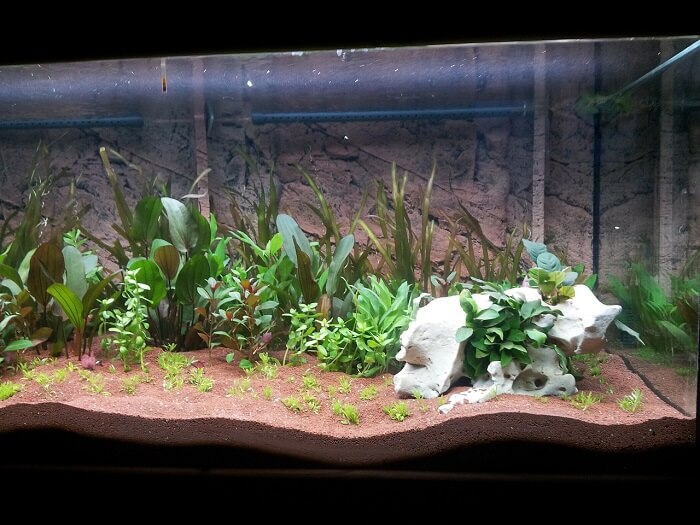
Most Angelfish look exquisite and enjoy a lush tropical tank with many plants and hideouts. A more natural scenery will be ideal for you and create the perfect display in your home.
Substrate For The Pink Angelfish
Angelfish do enjoy foraging at the bottom of their tank, thus you need to be mindful of your choice in the substrate. A smooth, small to medium size gravel that will cover the ground sufficiently is suitable and ideal for planting some Aquatic plants in your tank.
Decorations For Your Tank
As I have mentioned before, Angelfish do enjoy a more lush and natural tank environment with space to hide out, as they are generally quite territorial. However, you also want to give them enough open space to swim. You can use live or synthetic plants and other decorations.
Tank Decor And Hideouts
- Synthetic Plants.
Just ensure that the decor that you choose is safe with no rough surfaces or sharp edges.
Live Plants
Live plants can provide some vegetation, and also help to clean and oxygenate the water in your tank, they are an ideal choice;
- Jungle Vallisneria
- Java ferns
- Water Sprites
- Amazon sword
- Anubias
- Bolbitis
- Anacharis
- Dwarf Tiger Lotus
Choosing A Healthy Freshwater Pink Angelfish
The Pink Freshwater Angelfish is quite rare so you will have to do some research in order to get a breeder or pet store that does stock them. To ensure your Angelfish is in good health the fins need to be erect and not show any damage. Look for a perky and more active fish that swims around with no deformations or a swollen belly. There should also not be any white spots or fuzz on the Angelfish which could indicate parasites.
Placing Your Freshwater Angelfish In Its New Tank
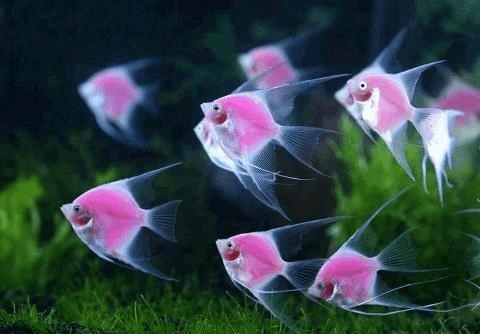
It is always a good idea to let your completed tank run through a cycle for a few days to a week before adding your new fish. Ensure that all the water levels are at peak condition before adding your new fish, and follow these steps;
- Only introduce one fish at a time into your new tank.
- Place the fish in its bag of water to float in the tank for 20 to 30 minutes so that it can acclimate to the new tank temperatures.
- Open the bag and remove one cup of water at a time, replacing it with water from the tank. Do this every 15 to 20 minutes for an hour or so.
- Now you may release the fish in the water ensuring not to empty the entire contents of the bag.
- Check on your new Angelfish to ensure that it is in good shape the first few days, and give it some time before adding more Angelfish or Tank Mates.
Selecting Tank Mates
Angelfish in general are pretty social and they do tend to school, so you can keep more than one of the same or different color variations. If you would like to add some other freshwater fish varieties you will need to do some research on getting the right tank mates. More aggressive species of fish may harm your Angelfish, and Angelfish are well known for ambushing prey on smaller fish species.
When Angelfish get older they are also notorious for becoming territorial, so it is important to add something new to the tank or change their surroundings before adding a new fish. This creates new interest for them and also interrupts their territorial behavior towards a new tank mate.
You can choose from the Following List of FreshWater tropical fish that will make perfect tank mates for your Pink Angelfish;
- The Corydoras Catfish
- Zebra Loaches
- Gouramis
- Platies
- Mollys
- Rainbow Fish (Boesemani)
- Plecos
You can also introduce some snail species, along with your Corydoras Catfish which will help to keep the tank clean.
Tank Maintenance
One of the most crucial factors to keep your Angelfish happy, healthy and stress-free is to ensure that their tank is kept clean. Keeping tropical fish is a hobby that requires some work, unfortunately, however, it can be most rewarding.
You will need to do a weekly or bi-weekly change of the water, by replacing 10 to 20% of the tank’s water with clean, conditioned, and tested new water.
In the video you will see some clearer instructions on how to clean, and change the water in your Angelfish tank;
Plants need to be kept clean, along with decorations, and a tank vacuum can come in quite handy to keep your tank spotless and healthy.
Feeding
Angelfish are said to be Omnivores though they do consume slightly more protein and meat-based foods than most omnivorous fish. They are easy to feed and will feed from the top, bottom, and even middle of the water in your tank.
Most of their diet consists of quality pellets or flakes, from a trusted brand, frozen and live meat-based foods, and some vegetation. It is also important that they get a balanced diet with the right quantity of fiber to prevent any digestive issues.
If you find that your Pink Angelfish is not eating, and losing weight, the article from Your Aquarium Place is quite a good source to help you find answers.
How Often And How Much Should You Feed
Angelfish in general are not fussy when it comes to eating, they will eat readily and also quite a variety of foods. They will need to be fed once or twice a day, about as much as they can finish within a few minutes, and no more.
1. Feeding Live Foods
Angelfish thoroughly enjoy meat-based frozen and live foods and you can include the following in their diet;
- Ground beef heart, just be careful as it can quickly degrade your tank water quality.
- Tubifex Worms are ideal for many nutrients.
- Bean Beetles and their Larvae.
- Brine Shrimp.
- Flour Beetles.
- Chopped up Earthworms.
- Black Soldier Flies and their Larvae.
2. Feeding Vegetables and Greens
Most of the live plants in your tanks should be safe for them to nibble on, however, they enjoy foods such as algae, algae wafers, and other leaf varieties. Romaine Lettuce, spinach, and thinly sliced zucchini or squash can also be given. Ensure that all vegetables are blacked and cooled first, to make it easier for them to consume.
Temperament And Personality
Pink Angelfish, as with all Freshwater Angelfish species, are peaceful and graceful. They are social and enjoy a few tank mates, and are likewise prone to School.
However, one factor should be kept in mind, they are territorial and do tend to get a bit on edge during the breeding season.
Common Health Issues
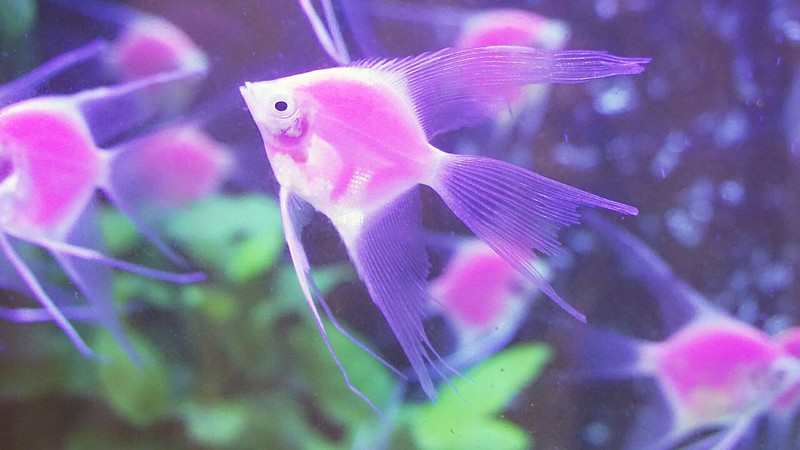
As long as you keep your tank clean, your water conditions up to standard, and feed them a well-balanced diet most Angelfish species will thrive with no issues at all;
Here are some common conditions that mostly affect Angelfish;
1. Fin Rot
A basic bacterial infection is caused by fluctuating water conditions because of water not being kept clean. It affects the fins and moves toward the body. You can use an antibiotic from a veterinarian and make sure to clean your tank regularly.
2. Ich
Also called the White Spot disease, is a stress-induced disease because tank conditions are not up to standard. It can be treated by placing the affected fish in quarantine until the parasite disappears.
3. Dropsy
Your Angelfish may become bloated, with rapid breathing, and slightly protruding eyes, which means it has a compromised immune system causing Dropsy. A veterinarian can prescribe an antibiotic.
4. Spironucleus-Associated Necrotic Enteritis In Angelfish
This is a type of internal parasite that can attack Angelfish, it is not very common, however, you can read more about it from the scientific NCBI documents.
5. Physical Damage
Lastly, I want to include physical damage. Many Angelfish may be bullied by other fish, harmed by tank decorations, or even by handling. Prevention is better than cure in this case so keep tank decorations safe, and ensure you get them non-aggressive tank mates. They should also not be handled. Antibiotics can help to heal injured Angelfish.
Breeding
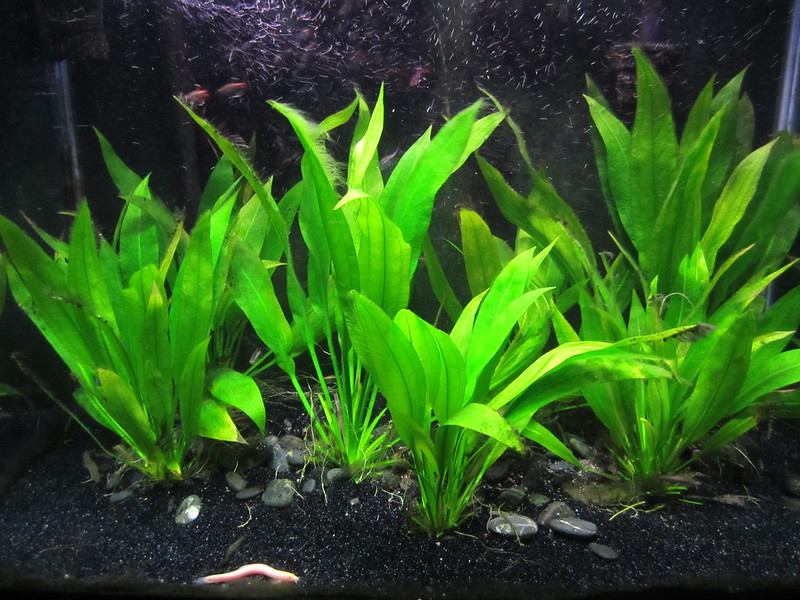
Pink Angelfish as with most Angelfish species are relatively easy to breed and quite contrary very interesting pairs and parents to watch. There is not much to do on your part when it comes to breeding Angelfish, they are Monogamous and will select a partner from a social group and stay with their partner, in some cases they will not take a new partner should one die.
The Parents spawn in designated areas and the female likes to lay her eggs on a flat surface such as a slate or broadleaf plant, such as the Amazon Sword Plant.
They may eat their first eggs or hatchlings but should lay more eggs soon after that and will become much more attentive as parents with every new batch.
The females will meticulously clean their eggs, and both parents will take care of and defend their fry until they are old enough to fend for themselves.
Here are a few things you can do though, to make breeding conditions more favorable for them;
- Pairing Off – Keep your Pink Angelfish in Groups, keeping in mind that other colored partners may not result in Pink Angelfish babies. Your Angelfish will select their own mates and pair off with them. You can learn more about mating rituals in How Do Angelfish Mate?
- Temperatures – Tank temperatures of 22 to 27 degrees Celsius (78 – 86 Degrees Fahrenheit).
- Tank pH – A pH of around 6.5 to 7.5 will be ideal for breeding.
- Tank Decor and Plants – The Angelfish will need an area such as a cave, driftwood, or other items in their tank to establish a safe haven for their breeding territory. They also do need plants which you can read more about in the VigyanVarta, for laying their eggs on and breeding.
- Feeding – Supplement the parent’s diet with Brine shrimp.
- Feeding Babies – When hatchlings are around five days or older you can feed them baby brine shrimp.
You can read the step-by-step instructions on breeding Angelfish on Wikihow.
To Conclude
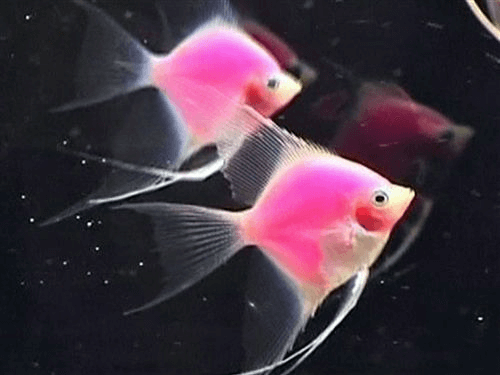
The Pink Angelfish is something truly wondrous to admire, and as with other breeds of FreshWater Angelfish, it is easy to keep and will give you quite a few years of beauty and interesting antics.


